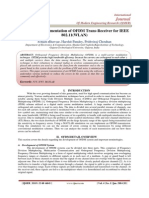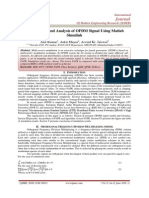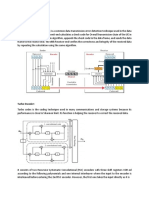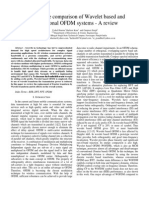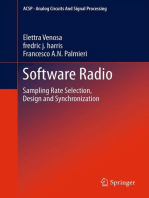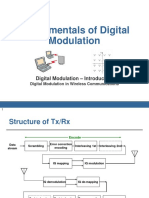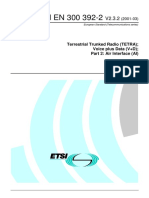Professional Documents
Culture Documents
Implementation of OFDM Transmitter and Receiver Using FPGA: Nasreen Mev, Brig. R.M. Khaire
Implementation of OFDM Transmitter and Receiver Using FPGA: Nasreen Mev, Brig. R.M. Khaire
Uploaded by
ankita6298Original Description:
Original Title
Copyright
Available Formats
Share this document
Did you find this document useful?
Is this content inappropriate?
Report this DocumentCopyright:
Available Formats
Implementation of OFDM Transmitter and Receiver Using FPGA: Nasreen Mev, Brig. R.M. Khaire
Implementation of OFDM Transmitter and Receiver Using FPGA: Nasreen Mev, Brig. R.M. Khaire
Uploaded by
ankita6298Copyright:
Available Formats
International Journal of Soft Computing and Engineering (IJSCE)
ISSN: 2231-2307, Volume-3, Issue-3, July 2013
Implementation of OFDM Transmitter and
Receiver Using FPGA
Nasreen Mev, Brig. R.M. Khaire
Abstract: Orthogonal Frequency Division Multiplexing
(OFDM) is the most promising modulation technique. It has
been adopted by most wireless and wired communication
standards. The idea is to utilize a number of carriers, spread
regularly over a frequency band, in such a way so that the
available bandwidth is utilized to maximal efficiency. The
objective of this paper is to carry out an efficient implementation
of the OFDM system (i.e. transmitter and receiver) using Field
Programmable Gate Array (FPGA) and find the result by
simulating all the blocks used in proposed project by using
QuartusII & Modelsim simulation tool.
Keywords- OFDM, FPGA.
I. INTRODUCTION
The OFDM is the modulation scheme having multi carrier
transmission techniques here the available spectrum is
divided into many carriers each one being modulated at a
low rate data stream. The spacing between the carriers is
closer and the carriers are orthogonal to one another
preventing interferences between the closely spaced carriers
hence OFDM can be thought of as a combination of
modulation and multiplexing techniques, each carrier in a
OFDM signal has very narrow bandwidth so the resulting
symbol rate is low which means that the signal has high
tolerance to multi path delay spread reducing the possibility
of inter symbol interference (ISI)which is the requirement
for todays communication systems.
OFDM is similar to FDM but much more spectrally efficient
by spacing the sub-channels much closer together (until they
are actually overlapping). This is done by finding
frequencies that are orthogonal, which means that they are
perpendicular in a mathematical sense, allowing the
spectrum of each sub-channel to overlap another without
interfering with it. In Figure 1.1 the effect of this is seen, as
the required bandwidth is greatly reduced by removing
guard bands (which are present in FDM) and allowing
signals to overlap.
A. Orthogonality
The key to OFDM is maintaining orthogonality of the
carriers. If the integral of the product of two signals is zero
over a time period, then these two signals are said to be
orthogonal to each other. Two sinusoids with frequencies
that are integer multiples of a common frequency can satisfy
this criterion. Therefore, orthogonality is defined by:
2
2
0
(
)
where n and m are two unequal integers; f is the
fundamental frequency; T is the period over which the
integration is taken. For OFDM, T is one symbol period
for optimal effectiveness.
and f set to
B. Field Programmable Gate Array
By modern standards, a logic circuit with 20000 gates is
common. In order to implement large circuits, it is
convenient to use a type of chip that has a large logic
capacity. A field programmable gate arrays (FPGA) is a
programmable logic device that support implementation of
relatively large logic circuits [6]. FPGA is different from
other logic technologies like CPLD and SPLD because
FPGA does not contain AND or OR planes.
Instead, FPGA consists of logic blocks for implementing
required functions.
An FPGA contains 3 main types of resources: logic blocks,
I/O blocks for connecting to the pins of the package and
interconnection wires and switches. The logic blocks are
arranged in a two-dimensional array, and the
interconnection wires are organized as horizontal and
vertical routing channels between rows and columns of logic
blocks [7].
The routing channels contain wires and programmable
switches that allow the logic blocks to be interconnected in
many ways. FPGA can be used to implement logic circuits
of more than a few hundred thousand equivalent gates in
size [7]. Equivalent gates is a way to quantify a circuits size
by assuming that the circuit is to be built using only simple
logic gate and then estimating how many of these gates are
needed. Figure 1.2 a clear picture of the FPGA design flow.
Figure 1.1 Spectrum overlap in OFDM
Manuscript received on July, 2013
Nasreen Mev is astudent of M.Tech (in VLSI Design) in Electronics
Department of College of Engineering, Bharati Vidyapeeth Deemed
University Pune (MS) India.
Prof. Brig. R.M. Khaire is working as a Head of Department in
Electronics and Telecommunication, Bharati Vidyapeeth Deemed
University Pune (MS) India.
199
Figure 1.2FPGA design flow
Implementation of OFDM Transmitter and Receiver Using FPGA
depends upon the last k data symbols, therefore k is known
as the constraint length of the Convolutional code.
Viterbi algorithm is used to decode convolutionaly encoded
bits at the receiver side.
Viterbi decoding algorithm is most suitable for
Convolutional codes with k 10.
II. OFDM TRANSMITTER & RECEIVER
Block Diagram
D. Interleaver/De-Interleaver
Interleaving is done to protect the data from burst errors
during transmission. Conceptually, the in-coming bit stream
is re-arranged so that adjacent bits are no more adjacent to
each other. The data is broken into blocks and the bits
within a block are rearranged. Talking in terms of OFDM,
the bits within an OFDM symbol are rearranged in such a
fashion so that adjacent bits are placed on non-adjacent subcarriers.
As far as De-Interleaving is concerned, it again rearranges
the bits into original form during reception.
E. Constellation Mapper/De-Mapper
The Constellation Mapper basically maps the incoming
(interleaved) bits onto different sub-carriers. Different
modulation techniques can be employed (such as QPSK,
BPSK, QAM etc.) for different sub-carriers. The De-Mapper
simply extracts bits from the modulated symbols at the
receiver.
Fig1.3 Complete OFDM System
A. Scramble/Descramble
Data bits are given to the transmitter as inputs. These bits
pass through a scrambler that randomizes the bit sequence.
This is done in order to make the input sequence more
disperse so that the dependence of input signals power
spectrum on the actual transmitted data can be eliminated.
At the receiver end descrambling is the last step.
Descrambler simply recovers original data bits from the
scrambled bits.
B. Reed-Solomon Encoder/Decoder
The scrambled bits are then fed to the Reed Solomon
Encoder which is a part of Forward Error Correction (FEC).
Reed Solomon coding is an error-correction coding
technique. Input data is over-sampled and parity symbols
are calculated which are then appended with original data
[3]. In this way redundant bits are added to the actual
message which provides immunity against severe channel
conditions. A Reed Solomon code is represented in the form
RS (n, k), where
n= 2m 1
(1)
k = 2m 1 2t
(2)
Here m is the number of bits per symbol, k is the number of
input data symbols (to be encoded), n is the total number of
symbols (data + parity) in the RS codeword and t is the
maximum number of data symbols that can be corrected. At
the receiver Reed Solomon coded symbols are decoded by
removing parity symbols.
C. Convolutional Encoder/Decoder
Reed Solomon error-coded bits are further coded by
Convolutional encoder. This coder adds redundant bits as
well. In this type of coding technique each m bit symbol is
transformed into an n bit symbol; m/n is known as the code
rate. This transformation of m bit symbol into n bit symbol
F. Inverse Fast Fourier Transform/ Fast Fourier
Transform
This is the most important block in the OFDM
communication system. It is IFFT that basically gives
OFDM its orthogonality. The IFFT transform a spectrum
(amplitude and phase of each component) into a time
domain signal. It converts a number of complex data points
into the same number of points in time domain. Similarly,
FFT at the receiver side performs the reverse task i.e.
conversion from time domain back to frequency domain.
G. Addition/Removal of Cyclic Prefix
In order to preserve the sub-carrier orthogonality and the
independence of subsequent OFDM symbols, a cyclic guard
interval is introduced. The guard period is specified in terms
of the fraction of the number of samples that make up an
OFDM symbol. The cyclic prefix contains a copy of the end
of the forthcoming symbol. Addition of cyclic prefix results
in circular convolution between the transmitted signal and
the channel impulse response. Frequency domain equivalent
of circular convolution is simply the multiplication of
transmitted signals frequency response and channel
frequency response, therefore received signal is only a
scaled version of transmitted signal (in frequency domain),
hence distortions due to severe channel conditions are
eliminated. Removal of cyclic prefix is then done at the
receiver end and the cyclic prefixfree signal is passed
through the various blocks of the receiver.
III. SPECIFICATION OF TRANSMITTER & RECEIVER
Figure 1.3 shows a top-level block diagram of the OFDM
transmitter and receiver. Single-Clock operation speaks
itself for the synchronous operation of the system. The Reset
input must be asserted for at least one clock cycle for the
system to reset. Output of the transmitter is fed to the host
PC via the serial port and also to the OFDM receiver.
Specifications are listed below:
200
International Journal of Soft Computing and Engineering (IJSCE)
ISSN: 2231-2307, Volume-3, Issue-3, July 2013
OFDM with 64 sub-carriers (all data sub-carriers)
All the sub-carriers are modulated using QPSK
IFFT: 64-point. Implemented using FFT radix 22
algorithm
Channel coding: Reed Solomon code + Convolution
code
Reed Solomon Encoder: RS (15, 9)
Convolution Encoder: m=1, n=2, k=7. Code rate =
Block Interleaver and 1/8 Cyclic Prefix
IV. RESULTS
A. Srambler
To verify proper functioning of the Scrambler was initially
fed with a seed value of 1110101 and the following input bit
stream was given to the Scrambler:
in: 0110101000
The output was:
out: 1101110001
For a 7 bit input a 14 bit output is generated. Once again this
circuit was taken through a dry run using high level
modeling in Verilog and the results were verified.
D. Interleaver
The waveform for the interleaver goes upto 128 clock
cycles. Therefore, it is not shown here. For an input block of
data containing alternate 1s and 0s the output was
out:
0000000011111111000000001111111100000000.
so on
This clearly shows how bit positions have been changed.
E. Constellation Mapper
Following wave form shows that when an input of 10 was
given to the Constellation Mapper the output was,
out: 00b504ff4afch
Figure 1.7 Constellation Mapper simulation results
Figure 1.4 Scrambler simulation results
After a dry run of the scrambler using high-level modelling
in Verilog it was verified that the output was correct.
B. Read Solomon Encoder
In order to check the proper functioning of Reed Solomon
Encoder a test bench waswritten in Verilog. The input given
to the encoder through the test bench was a string of
alternating 36 (9 symbols) bits starting with 0. Such that:
in: 555555555H
It is well known in the art that if all the input symbols to a
Reed Solomon encoder areidentical, then the parity symbols
will all be identical as well and will be equal to the input
symbols. Therefore, the output turned out to be
out: 555555555555555H
Figure 1.5 Reed Solomon Encoder simulation results
C. Convolutional Encoder
After simulation of the above shown Verilog code the
following waveform wasgenerated. It can be seen that first
of all a low pulse was given to the arst_n (reset) inputin
order to initialize the shift register with all zeroes. Next the
following bit stream wasgiven at the input,
in: 1011101
The output turned out to be,
out: 11010001011100
F. IFFT
The IFFT was tested by giving the following 64 complex
data points,
h00b504000000,h030000000000,
h00b504000000,,
h00b504000000
Figure 1.8 IFFT simulation results
The outputs were,
h2f8bc000000, h5db504000000, h0000005db504 and so on.
G. Cyclic Prefix Adder
The inputs given to the cyclic prefix adder were
47'h000000100101,47'h000010100001,
47'h001110100101,47'h110010100101,
47'h000010100101,47'h010101000101, 47'h011110100101,
47'h000011100101. . .
47'h000011100101
The outputs turned out to be
47'h000011100101,47'h000011100101, 47'h000011100101,
47'h000011100101,
47'h000011100101,47'h000011100101, 47'h000011100101,
47'h000011100101,
47'h000000100101,47'h000010100001, 47'h001110100101,
47'h110010100101,
47'h000010100101,47'h010101000101,
47'h011110100101,47'h000011100101..
.
.47'h000011100101
Note that the first eight outputs are actually the last eight
inputs and the rest of the output points are same as the
inputs
Figure 1.6 Simulation Waveform of the Convolutional
Encoder
Figure 1.9 Cyclic Prefix Adder simulation result
201
Implementation of OFDM Transmitter and Receiver Using FPGA
H. Constellation Demapper
The constellation demapper basically maps the incoming
QPSK constellation points to actual data.
[7]
[8]
[9]
[10]
[11]
Figure 1.10 Constellation De-Mapper simulation results
I. De-Interleaver
Just like the interleaver the simulation waveform of deinterleaver extends to 128 cycles so cant be shown here.
J. Descrambler
The inverse of scrambling is done by the De-Scrambler. For
the input,
b111111111000000000
the output was,
b110111111111000010
[12]
[13]
[14]
Aseem Pandey, Shyam Ratan Agrawalla & Shrikant Manivannan,
VLSI Implementation of OFDM, Wipro Technologies, September
2002.
Dusan Matiae OFDM as a possible modulation technique for
multimedia applications in the range of mm waves, TUD-TVS,
1998.
J. L. Holsinger, Digital communication over fixed time-continuous
channels with memory, with special application to telephone
channels, PhD thesis, Massachusetts Institute of Technology, 1964.
R. W. Chang, Synthesis of band-limited orthogonal signals for
multichannel data transmission, Bell Systems Technical Journal,
45:17751796, December 1966.
Shahid Abbas, Student Member, IEEE, Waqas Ali Khan, Talha Ali
Khan and Saba Ahmed OFDM Baseband Transmitter
Implementation Compliant IEEE Std 802.16d on FPGA2009
S. Weinstein and P. Ebert Data transmission by frequency-division
multiplexing using the discrete Fourier transform. IEEE
Transactions on Communications, 19(5):628634, October 1971.
L. J. Cimini Analysis and simulation of a digital mobile channel
using orthogonal frequency division multiplexing. IEEE
Transactions on Communications, 33(7):665675, July 1985.
Lattice Semiconductor white paper, Implementing WiMAX OFDM
Timing and Frequency Offset Estimation in Lattice FPGAs, 2005.
NASREEN MEV is astudent of M.Tech (in VLSI Design) in Electronics
Department of College of Engineering, Bharati Vidyapeeth Deemed
University Pune (MS) India. She has completed B.E.in Electonics &
communication from Ujjain Engg. College Ujjain(M.P.) India.
PROF. BRIG. R.M. KHAIRE is working as a Head of Department in
Electronics and Telecommunication, Bharati Vidyapeeth Deemed
University Pune (MS) India. He has completed his M-Tech from IIT
Chennai . He is retired Brigadier from Indian army.
Figure 1.11 De-Scrambler simulation results
V. CONCLUSION
Orthogonal Frequency Division Multiplexing ( OFDM)
transmitter and receiver have been design using Quartus II
tool and Simulation have been carried out using Altera
Modelsim simulation tool. By using channel coding &
decoding methods and error detection & correction methods
synthesis and analysis has been done and how exactly
OFDM system works, is verified. Verilog is used as
Hardware Description Language (HDL) to program all the
components of the OFDM Transmitter and Receiver and
verification of functionality of all components has done by
giving different input and output is verifieid. It is also found
out that how many number of logic elements and memory
bits are required to design each component.
REFERENCES
[1]
[2]
[3]
[4]
[5]
[6]
Ahmed R. S. Bahai and Burton R. Saltzberg, Multi Carrier Digital
Communication. Kluwer Academic Publishers, 2002.
G.M. Bhat, M. Mustafa, Shabir Ahmad and Javaid Ahmad
modelling and simulation of data scrambler and descrambler for
secure data communication, Indian Journal of Science and
Technology 2009.
Dapeng Hao, Pin Yao, and Peter Adam Hoeher Analysis and
Design of Interleaver Sets for Interleave-Division Multiplexing and
Related Techniques 5th International Symposium on Turbo Codes
and Related Topics 2008.
Doelz, M.L., Heald E.T. and Martin D.L. "Binary Data Transmission
Techniques for Linear Systems." Proc. I.R.E., 45: 656-661, May
1957.
S. B. Weinstein and P. M. Ebert, Data transmission by frequencydivision multiplexing using the discrete Fourier transform, IEEE
Trans. Communications, COM-19(5): 628-634, Oct. 1971.
Jeffrey G. Andrews, Rias Muhammad, Fundamentals of WIMAX.
Prentice Hal Communications Engineering, 2006.
202
You might also like
- Simulation of Digital Communication Systems Using MatlabFrom EverandSimulation of Digital Communication Systems Using MatlabRating: 3.5 out of 5 stars3.5/5 (22)
- Seimetz M. High-Order Modulation For Optical Fiber Transmission (Springer, 2009) (3540937706) PDFDocument262 pagesSeimetz M. High-Order Modulation For Optical Fiber Transmission (Springer, 2009) (3540937706) PDFMuhammad Usman JavedNo ratings yet
- UNV-SIM868 V2.0 User Manual V1.0 PDFDocument8 pagesUNV-SIM868 V2.0 User Manual V1.0 PDFcccaligulaNo ratings yet
- Chapter 9Document4 pagesChapter 9Janica Rheanne JapsayNo ratings yet
- Project Report 359Document12 pagesProject Report 359Sayeed Habeeb100% (1)
- Design of OFDM Reciever: ISSN 2319-9725Document0 pagesDesign of OFDM Reciever: ISSN 2319-9725ohenri100No ratings yet
- Performance Analysis of MIMO-OFDM System Using QOSTBC Code Structure For M-QAMDocument12 pagesPerformance Analysis of MIMO-OFDM System Using QOSTBC Code Structure For M-QAMNoha HassanNo ratings yet
- Behaviour of OFDM System Using MATLAB SimulationDocument5 pagesBehaviour of OFDM System Using MATLAB Simulationsreekanthreddy peramNo ratings yet
- Implementation and Performance Evaluation of OFDM System in Diverse Transmission Channel Using SimulinkDocument7 pagesImplementation and Performance Evaluation of OFDM System in Diverse Transmission Channel Using SimulinkAbdallah ToolmakerNo ratings yet
- Performance Analysis of OFDM For Different Modulation TechniquesDocument6 pagesPerformance Analysis of OFDM For Different Modulation Techniquesrahman08413No ratings yet
- Chapter-1: 1.1. Wireless Communication SystemsDocument28 pagesChapter-1: 1.1. Wireless Communication Systemskarthick_mariner92No ratings yet
- BER Analysis of MIMO-OFDMDocument10 pagesBER Analysis of MIMO-OFDMAbhijeet KumarNo ratings yet
- Design and Implementation of OFDM Trans-Receiver For IEEE 802.11 (WLAN)Document13 pagesDesign and Implementation of OFDM Trans-Receiver For IEEE 802.11 (WLAN)IJMERNo ratings yet
- Ofdm With MatlabDocument4 pagesOfdm With Matlabmaitham100No ratings yet
- Comparison of DCT and Wavelet Based Ofdm System Working in 60 GHZ BandDocument10 pagesComparison of DCT and Wavelet Based Ofdm System Working in 60 GHZ Bandsachin10dulkarNo ratings yet
- Transmitter Architecture For Pulsed Ofdm: Kai-Chuan Chang, Gerald E. Sobelman, Ebrahim Saberinia and Ahmed H. TewfikDocument4 pagesTransmitter Architecture For Pulsed Ofdm: Kai-Chuan Chang, Gerald E. Sobelman, Ebrahim Saberinia and Ahmed H. TewfikPramanshu SinghNo ratings yet
- A Comparative Performance Analysis of OFDM Using MATLAB Simulation With M-PSK and M-QAM MappingDocument5 pagesA Comparative Performance Analysis of OFDM Using MATLAB Simulation With M-PSK and M-QAM MappingShilpa SharmaNo ratings yet
- BER of OFDM System Using Concatenated Forward Error Correcting Codes (FEC) Over Nakagami-M Fading ChannelDocument5 pagesBER of OFDM System Using Concatenated Forward Error Correcting Codes (FEC) Over Nakagami-M Fading Channelseventhsensegroup100% (1)
- Comparative Evaluation of Bit Error Rate For Different Ofdm Subcarriers in Rayleigh ChannelDocument8 pagesComparative Evaluation of Bit Error Rate For Different Ofdm Subcarriers in Rayleigh ChannelLawrence AveryNo ratings yet
- GOYANI - A Review - Performance Comparison of Conventional and Wavelet Based OFDM SystemDocument4 pagesGOYANI - A Review - Performance Comparison of Conventional and Wavelet Based OFDM SystemAnonymous PsEz5kGVaeNo ratings yet
- MIMO-OFDM High Data Rate Wireless System Using V-BLAST MethodDocument9 pagesMIMO-OFDM High Data Rate Wireless System Using V-BLAST MethodInternational Journal of Application or Innovation in Engineering & ManagementNo ratings yet
- Design Low Power Physical Layer of NB-IOT LTE Uplink ReceiverDocument17 pagesDesign Low Power Physical Layer of NB-IOT LTE Uplink Receiversadsadasdsad asdasdaNo ratings yet
- WC & LTE 4G - Module 2Document57 pagesWC & LTE 4G - Module 2kirankumar humseNo ratings yet
- Analysis of Wavelet Based OFDM SystemDocument8 pagesAnalysis of Wavelet Based OFDM Systemhk_sonuNo ratings yet
- 5.another Format Paper 2Document6 pages5.another Format Paper 2iisteNo ratings yet
- Introduction of Orthogonal FrequencyDocument8 pagesIntroduction of Orthogonal FrequencysmuthsuddyNo ratings yet
- Ofdm Simulink ModelDocument57 pagesOfdm Simulink ModelPankaj Pandey50% (2)
- Performance Evaluation of OFDM System With Rayleigh, Rician and AWGN Channelst Report Manmeet KhuranaDocument7 pagesPerformance Evaluation of OFDM System With Rayleigh, Rician and AWGN Channelst Report Manmeet KhuranaManmeet Singh KhuranaNo ratings yet
- Investigating 802.11A Wireless Standard For High Speed Network Using Different Modulation TechniquesDocument5 pagesInvestigating 802.11A Wireless Standard For High Speed Network Using Different Modulation TechniqueserpublicationNo ratings yet
- Performance and Analysis of OFDM Signal Using Matlab SimulinkDocument7 pagesPerformance and Analysis of OFDM Signal Using Matlab SimulinkIJMERNo ratings yet
- Relationship Between EsN0 and EbNo in OFDMDocument8 pagesRelationship Between EsN0 and EbNo in OFDMfriendindeedNo ratings yet
- Comparative Analysis of Ber Performance of DWT Based Ofdm System With Conventional FFT Based Ofdm SystemDocument6 pagesComparative Analysis of Ber Performance of DWT Based Ofdm System With Conventional FFT Based Ofdm Systemhk_sonuNo ratings yet
- The LabVIEW Simulation of Space-Time Coding Technique in The MIMO-OfDM SystemDocument6 pagesThe LabVIEW Simulation of Space-Time Coding Technique in The MIMO-OfDM Systemivy_publisherNo ratings yet
- Ijesat 2012 02 Si 01 02Document4 pagesIjesat 2012 02 Si 01 02Ijesat JournalNo ratings yet
- OFDM in VerilogDocument6 pagesOFDM in VerilogMarwan AhmedNo ratings yet
- A Humble Method Based On Trimming and Differential Topping To Reduce The PAPR in OFDM SystemsDocument6 pagesA Humble Method Based On Trimming and Differential Topping To Reduce The PAPR in OFDM SystemsseventhsensegroupNo ratings yet
- A Review On OFDM: Concept, Scope & Its Applications: Manushree Bhardwaj, Arun Gangwar, Devendra SoniDocument5 pagesA Review On OFDM: Concept, Scope & Its Applications: Manushree Bhardwaj, Arun Gangwar, Devendra SonipankajmudgilNo ratings yet
- Improving Ber Using Turbo Codes in Ofdm SystemsDocument5 pagesImproving Ber Using Turbo Codes in Ofdm Systemsmohammed ayadNo ratings yet
- Performance Improvement of Mc-Cdma System Through DSTBC Site DiversityDocument8 pagesPerformance Improvement of Mc-Cdma System Through DSTBC Site Diversityمحمد الطراونهNo ratings yet
- Comparison of OFDM, SC-FDMA and MC-CDMA As AccessDocument7 pagesComparison of OFDM, SC-FDMA and MC-CDMA As AccessFarman Ullah100% (1)
- OFDM Project-Group11Document28 pagesOFDM Project-Group11Bảo Ngọc LêNo ratings yet
- Different Channel Coding Techniques in MIMO-OFDMDocument5 pagesDifferent Channel Coding Techniques in MIMO-OFDMHameed Ullah MarwatNo ratings yet
- What Is OFDMDocument4 pagesWhat Is OFDMmaheshbabuhereNo ratings yet
- Introduction To Ofdm: Nayan SenDocument19 pagesIntroduction To Ofdm: Nayan SenNayan SenNo ratings yet
- Modeling of An ADSL Transceiver Data Transmission Subsystem: Elmustafa ErwaDocument9 pagesModeling of An ADSL Transceiver Data Transmission Subsystem: Elmustafa ErwaIrving Peña BalderasNo ratings yet
- Mathematical Description of OFDMDocument8 pagesMathematical Description of OFDMthegioiphang_1604No ratings yet
- (IJIT-V6I5P6) :DR - Mustafa ÖZKANDocument8 pages(IJIT-V6I5P6) :DR - Mustafa ÖZKANIJITJournalsNo ratings yet
- Report 145Document8 pagesReport 145sadsadasdsad asdasdaNo ratings yet
- Ofdm (Orthogonal Frequency Division Multiplexing)Document28 pagesOfdm (Orthogonal Frequency Division Multiplexing)Aastha Gupta100% (1)
- Nonlinear Channels Characterization in OFDM Systems Using Spectral Notch SignalsDocument8 pagesNonlinear Channels Characterization in OFDM Systems Using Spectral Notch SignalsInternational Organization of Scientific Research (IOSR)No ratings yet
- MODULE-2 - 15EC81: OFDM BasicsDocument20 pagesMODULE-2 - 15EC81: OFDM BasicsthejasNo ratings yet
- IEEE Bare Demo Template For ConferencesDocument4 pagesIEEE Bare Demo Template For ConferenceskailashNo ratings yet
- Researchpaper OFDM Modulator For Wireless LAN WLAN StandardDocument5 pagesResearchpaper OFDM Modulator For Wireless LAN WLAN Standardtsk4b7No ratings yet
- Performance Enhancement of MIMO-OFDM System Using PTS To Achieve Optimum BER & PaprDocument9 pagesPerformance Enhancement of MIMO-OFDM System Using PTS To Achieve Optimum BER & PaprInternational Journal of Application or Innovation in Engineering & ManagementNo ratings yet
- Performance Comparison of Wavelet Based and Conventional OFDM Systems - A ReviewDocument4 pagesPerformance Comparison of Wavelet Based and Conventional OFDM Systems - A ReviewkiaraNo ratings yet
- Ijtra 140812Document3 pagesIjtra 140812Akshay Kumar PandeyNo ratings yet
- 15ec81 Module 2Document55 pages15ec81 Module 2prajwal c nNo ratings yet
- An Overview of Ofdm and Related Techniques Towards Development oDocument4 pagesAn Overview of Ofdm and Related Techniques Towards Development oyadhardha LingalaNo ratings yet
- AbstractDocument20 pagesAbstractaman_tanvirNo ratings yet
- High-Performance D/A-Converters: Application to Digital TransceiversFrom EverandHigh-Performance D/A-Converters: Application to Digital TransceiversNo ratings yet
- Radio Frequency Identification and Sensors: From RFID to Chipless RFIDFrom EverandRadio Frequency Identification and Sensors: From RFID to Chipless RFIDNo ratings yet
- Software Radio: Sampling Rate Selection, Design and SynchronizationFrom EverandSoftware Radio: Sampling Rate Selection, Design and SynchronizationNo ratings yet
- AVOVO Satcom CybernetDocument22 pagesAVOVO Satcom CybernetMuhammad Shahroz AfzalNo ratings yet
- Lab 4 Line Coding TechniquesDocument10 pagesLab 4 Line Coding TechniquesAdnan AkhtarNo ratings yet
- Digital Audio BroadcastingDocument14 pagesDigital Audio Broadcastingbindug1100% (1)
- Analog Transmission: Ask, FSK, PSK & QPSK: Dept. of Computer Engineering Faculty of EngineeringDocument36 pagesAnalog Transmission: Ask, FSK, PSK & QPSK: Dept. of Computer Engineering Faculty of EngineeringShahabuddin SarkerNo ratings yet
- CMPS14 - Documentation: 3.3v-5v Sda/Tx SCL/RX Mode Factory Use 0v GroundDocument7 pagesCMPS14 - Documentation: 3.3v-5v Sda/Tx SCL/RX Mode Factory Use 0v GroundRidhoNo ratings yet
- Throughput Enhancement of IEEE 802.11 WLAN For Next Generation CommunicationsDocument68 pagesThroughput Enhancement of IEEE 802.11 WLAN For Next Generation Communicationsnurcoe1902100% (1)
- Bandwith Efficient ModulationDocument65 pagesBandwith Efficient ModulationelbertNo ratings yet
- C328 7640Document14 pagesC328 7640viorica88No ratings yet
- Ask, FSK, PSK and Qam: By: Samuel A.@MWUDocument54 pagesAsk, FSK, PSK and Qam: By: Samuel A.@MWUelias asefaNo ratings yet
- Blind OFDM Channel Estimation Through Simple Linear PrecodingDocument9 pagesBlind OFDM Channel Estimation Through Simple Linear Precodingkvkumar294No ratings yet
- 31 Digital ModulationDocument38 pages31 Digital Modulation江亞霖No ratings yet
- Guide To Wireless Communications 3rd Edition Olenewa Solutions ManualDocument6 pagesGuide To Wireless Communications 3rd Edition Olenewa Solutions ManualJohnDeckerfrgam100% (14)
- En 30039202v020302pDocument801 pagesEn 30039202v020302psafie147No ratings yet
- Tutorial 1 AnswerDocument4 pagesTutorial 1 AnswerRazzan WaheedNo ratings yet
- FCN Unit-Ii McqsDocument24 pagesFCN Unit-Ii McqsMarcus FNo ratings yet
- Digital Modulation in Communications Systems - AgilentDocument48 pagesDigital Modulation in Communications Systems - Agilentapi-19660619No ratings yet
- (Chapter 07) OFDM - Theory PDFDocument50 pages(Chapter 07) OFDM - Theory PDF01689373477No ratings yet
- BBIC 6 Channel EstimationDocument37 pagesBBIC 6 Channel EstimationYahia SelimNo ratings yet
- Full-Unit-3 - Baseband Shaping For Data TransmissionDocument93 pagesFull-Unit-3 - Baseband Shaping For Data Transmissionsaswati paramita100% (1)
- Emcs - 607P 11-07-2014Document68 pagesEmcs - 607P 11-07-2014abdulbari.abNo ratings yet
- App User Guide: Cgn-Dp2Document88 pagesApp User Guide: Cgn-Dp2Ciro Gonzales MariñoNo ratings yet
- Digital Transmission Through Bandlimited AWGN ChannelDocument174 pagesDigital Transmission Through Bandlimited AWGN ChannelYu Yu LNo ratings yet
- Estandar DVB T2 2012Document188 pagesEstandar DVB T2 2012Daniela Cardenas LuboNo ratings yet
- Paradise Datacom PD55 Evolution L-Band Satellite Modem Data Sheet 205084 RevLDocument5 pagesParadise Datacom PD55 Evolution L-Band Satellite Modem Data Sheet 205084 RevLarzeszutNo ratings yet
- Concepts of Orthogonal Frequency Division Multiplexing (OFDM) and 802Document4 pagesConcepts of Orthogonal Frequency Division Multiplexing (OFDM) and 802AndreNo ratings yet
- Digital CommunicationDocument53 pagesDigital CommunicationSrinivasu RajuNo ratings yet












